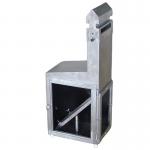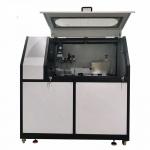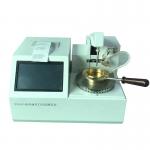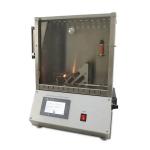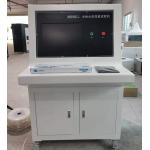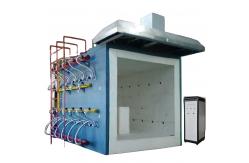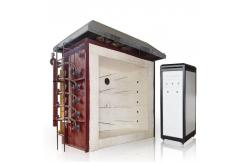In the field of fire safety testing, the Micro Control
Multifunctional Vertical Fire Resistance Test Furnace emerges as a
sophisticated and essential apparatus. It is designed to
comprehensively evaluate the fire resistance capabilities of a wide
range of materials and products. The Micro Control Multifunctional Vertical Fire Resistance Test
Furnace is a specialized device used to determine the fire
endurance and related properties of various materials. It finds
extensive application in research laboratories, building material
testing centers, and industries dealing with fireproof products. By
subjecting samples to a precisely controlled vertical fire
environment, it measures parameters such as temperature resistance,
flame penetration, and structural integrity over a specific period.
This data is crucial for assessing the suitability of materials for
use in fire-prone environments, ensuring compliance with safety
standards and regulations, and guiding the development and
improvement of fire-resistant materials and products. - Robust and Heat-Resistant Construction
- The test furnace is constructed from high-quality refractory
materials and heat-resistant alloys. The interior of the furnace is
engineered to provide a uniform and stable heat distribution,
minimizing any thermal gradients that could affect the accuracy of
the test results. The furnace lining is designed to withstand the
extreme temperatures and corrosive gases generated during the fire
test, ensuring a long service life and reliable performance.
- The exterior casing is built to protect the operator and the
surrounding environment from heat radiation and potential leaks. It
is equipped with a reliable sealing mechanism to prevent the escape
of flames and hot gases during the test, maintaining the integrity
of the test environment.
- Precision Instrumentation and Measurement Capabilities
- Equipped with advanced temperature sensors and a sophisticated data
acquisition system, the furnace can accurately measure the
temperature changes within the furnace and on the sample surface.
These sensors have a high sensitivity and rapid response time,
enabling the precise recording of temperature profiles. The data
acquisition system records all test data in real-time, including
temperature, time, and any changes in the physical properties of
the sample.
- Optical sensors are also incorporated to detect flame penetration
and the spread of fire within the sample. This allows for a
detailed assessment of the fire resistance of the material,
providing valuable information about its ability to prevent the
passage of flames. The user interface is intuitive and
user-friendly, allowing operators to easily set test parameters
such as heating rate, test duration, and target temperature. The
furnace can generate detailed reports, complete with graphs and
charts, that vividly illustrate the fire resistance performance of
the tested material.
- Microcontroller-Based Automation and Flexibility
- The Micro Control Multifunctional Vertical Fire Resistance Test
Furnace is equipped with a microcontroller that enables automated
control and monitoring of the test process. The microcontroller can
precisely adjust the heating elements to maintain the desired
temperature profile, ensuring accurate and reproducible test
results. It also allows for the programming of different test
sequences and scenarios, making the furnace suitable for a wide
variety of testing requirements.
- The furnace can be easily configured to perform different test
methods and standards, such as ASTM E119, BS 476, or other relevant
international and national standards. This flexibility makes it an
invaluable tool for both routine quality control testing and
in-depth research and development activities. The microcontroller
also provides real-time feedback and alerts in case of any abnormal
conditions, enhancing the safety and reliability of the testing
process.
- Technical parameters
| Instrument composition | Fire test furnace, gas flow measurement system, temperature
measurement system and pressure measurement and control system. | | Fire test furnace | It is a vertical test furnace with an inner size of 2.5M (length) x
2.5M (deep) x 1.25M (height). | | Furnace structure | Steel structure frame is used to form the furnace wall with
refractory brick in the middle of the steel structure frame. The
inner side of the furnace wall is made of high temperature
resistant heat insulation material with a density greater than
1000kg/M3. The outer side is wrapped with color steel, the
thickness of the furnace lining material is 65mm, and the test
temperature in the furnace is up to 1250℃. The furnace is produced,
installed and tested in our factory, and disassembled into suitable
reloading according to the preset function of your company. The
parts are packaged and transported into the trailer. | | Temperature measurement system | Available | | Thermocouple in the furnace | K-type nickel-chromium nickel-silicon thermocouple with wire
diameter of 2.0MM according to GB/T16839.1, heat-resistant
stainless steel casing with outer casing, heat-resistant material
in the middle, the length of the heat end extension sleeve is not
less than 25MM, a total of 5, the temperature accuracy is <±15℃. | | Backfire surface temperature measurement | Using a diameter of 0.5MM thermocouple, fusion welding in thickness
of 0.2MM, diameter of 12MM. | | On the round copper plate, the large nickel-chromium nickel-silicon
thermocouple according to GB/T16839.1 should cover the length and
width. | | Both are 30MM asbestos liners with a thickness of 2.0MM. 20 in
total | | Average temperature measurement | 8 thermocouples, suitable for GB/T7633-2008 and GB/T17428-2009 | | Maximum temperature measurement | The thermocouple is a measurement of 20 double doors with a molded
slab that can cover up to a maximum door width of 1200 mm. | | Mobile thermocouple | Using infrared thermometer measurement | | Internal thermocouple | 4 thermocouples, which are suitable for measuring the internal
temperature of the ventilation duct. | | Ambient temperature measurement | An armored thermocouple with a diameter of 3.0 mm is used, which
conforms to the large nickel-chromium nickel-silicon K-type
thermocouple specified in GB/T16839.1. | | Pressure measurement in the furnace | T-shaped measuring probe, measuring accuracy ± 2pa. Three pieces | | Loading system | Using a pressure sensor to measure | | Deformation measuring instrument | Using electronic deformation measuring device | | Slot probe | Made according to GB/T9978.1 standard | | Burner | There are 8 high-speed burners embedded in the furnace walls on
both sides, six on each side. Provides the heat needed to heat up
the furnace. | | Exhaust smoke | Three exhaust holes are installed in the furnace wall on the back
side of the furnace wall to connect to the flue behind, and the
flue gas in the furnace body is discharged. Control pressure. | | Fire hole | There are two fire holes on the back side wall of the furnace body
to observe the fire surface and flame of the test piece during the
test. | | Loading device | It adopts a cart, which is 3.5M high and 3.0M wide, and is composed
of a car body and a test piece platform. The car body is designed
with four ground wheels, which can be moved on the rail. The test
platform: 3.0m*3.0m square steel frame. During the test, the test
piece platform with the test piece was lifted onto the vehicle body
with an electric hoist, then the cart was | | pushed to the test position and fixed, and then the test was
started. | | Electrical control part | MCGS configuration software and PLC program using embedded
integrated industrial computer. Including: main control interface,
furnace temperature curve interface, test piece temperature
interface, history record interface and parameter determination
interface. |
- Accurate Fire Resistance Evaluation
- The primary function of the test furnace is to provide a detailed
and accurate assessment of the fire resistance of materials. By
precisely measuring temperature resistance, it determines how well
a material can withstand the heat without significant degradation.
A higher temperature resistance indicates a better ability to
maintain its structural and functional integrity during a fire,
which is essential for applications such as building construction,
industrial equipment protection, and the manufacturing of fireproof
products.
- The measurement of flame penetration and spread is equally
important. Materials that can effectively prevent flame passage are
crucial for creating fire barriers and compartments, reducing the
risk of fire spread and protecting adjacent areas. The furnace's
ability to monitor these parameters helps in understanding the
overall fire protection performance of the material and its
suitability for specific applications.
- Compliance with Safety Standards and Regulations
- The building and manufacturing industries are subject to strict
safety standards and regulations regarding fire resistance. The
Micro Control Multifunctional Vertical Fire Resistance Test Furnace
is a reliable tool for ensuring compliance. It enables
manufacturers and testing laboratories to conduct tests in
accordance with relevant standards, providing accurate and reliable
data to prove that their products meet the necessary fire
resistance criteria. This facilitates market access and enhances
consumer confidence in the safety of the products.
- Regulatory bodies rely on the test results obtained from this
equipment to enforce safety regulations. It serves as a dependable
means for inspectors and certifying agencies to determine the
suitability of materials and products for use in different
applications and environments, ensuring that only those that meet
the required safety levels are approved.
- Research and Development Support
- In the field of materials science and engineering, the test furnace
is an invaluable asset. It allows researchers to study the fire
behavior of new and innovative materials. For example, in the
development of advanced fire-retardant coatings, composite
materials, or new building materials with enhanced fire resistance,
the furnace can be used to evaluate the effectiveness of different
formulations and structures.
- By understanding how different factors influence the fire
resistance of materials, researchers can optimize the design and
composition of products. This could involve the addition of flame
retardants, the modification of material microstructures, or the
development of new manufacturing processes. The detailed data
provided by the test furnace serves as a roadmap for driving
innovation and improving the overall fire safety of various
industries.
- Stringent Manufacturing Process
- The Micro Control Multifunctional Vertical Fire Resistance Test
Furnace is manufactured under strict quality control procedures.
Each component is carefully sourced and inspected for quality and
performance. The assembly process is carried out by highly trained
technicians in a clean and controlled environment, ensuring the
proper alignment and functionality of all parts.
- The calibration of the heating elements, temperature sensors, and
other measurement systems is a critical and regular part of the
manufacturing process. It is performed using traceable reference
standards to guarantee the accuracy and reproducibility of the test
results. Rigorous quality audits and inspections are conducted at
various stages of production to maintain the highest level of
product quality.
- Quality Certification and Validation
Our test furnace has obtained relevant quality certifications and
has been validated by independent testing laboratories. It has been
proven to provide accurate and reliable test results, conforming to
the most demanding international and national safety standards for
fire resistance testing. We also continuously update and improve
our product based on the latest technological advancements and
customer feedback to ensure its long-term performance and
compliance.
- Building Materials Industry
- A leading manufacturer of fireproof doors used the Micro Control
Multifunctional Vertical Fire Resistance Test Furnace to develop a
new line of high-performance doors. The test results showed that
the doors had excellent temperature resistance and flame
penetration prevention capabilities, exceeding the requirements of
relevant building codes. This enabled them to market the doors as a
top choice for fire protection in commercial and residential
buildings, leading to increased sales and enhanced market
reputation.
- A producer of fire-resistant wall panels utilized the furnace to
optimize their product design. By testing different panel
compositions and structures, they were able to improve the fire
resistance and structural integrity of the panels. The resulting
panels were widely adopted in high-rise building construction,
contributing to enhanced fire safety in these structures.
- Electrical and Electronic Equipment Industry
- An electrical equipment manufacturer used the test furnace to
evaluate the fire resistance of enclosures for their products. The
data helped them select appropriate materials and designs to ensure
that the enclosures could protect the internal components from fire
damage. This led to improved product reliability and compliance
with industry safety standards, enhancing the company's
competitiveness in the market.
- A research team in the electronics industry used the Micro Control
Multifunctional Vertical Fire Resistance Test Furnace to study the
fire behavior of printed circuit boards (PCBs) with different
coatings and laminates. Their findings led to the development of
new PCB materials with enhanced fire resistance, reducing the risk
of fire-related failures in electronic devices.
- Research Institutions
- A research institute focused on sustainable building materials used
the furnace to investigate the fire resistance of bio-based
composites. The data obtained helped them understand the
limitations and potential improvements of these materials. They
were able to develop new bio-based composites with improved fire
resistance, contributing to the advancement of sustainable building
technology and the reduction of the environmental impact of the
construction industry.
- Another research institution used the test equipment to study the
fire performance of innovative insulation materials. Their research
led to the discovery of new insulation systems with excellent fire
resistance and thermal insulation properties, opening up new
possibilities for energy-efficient and fire-safe building design.
|
